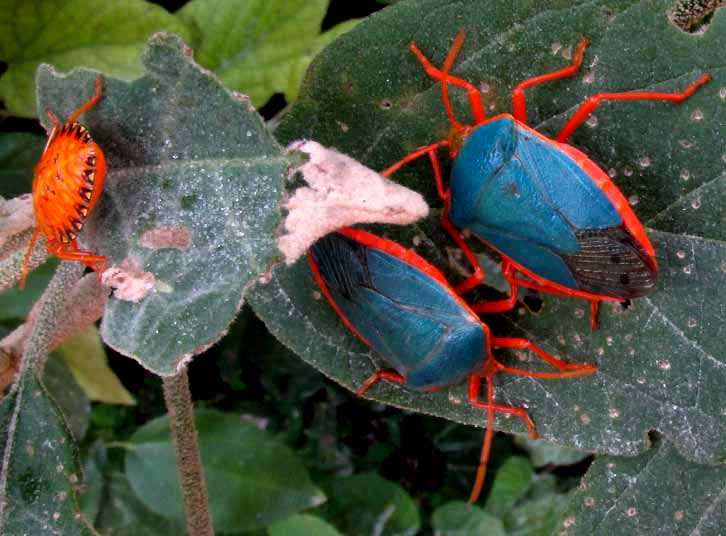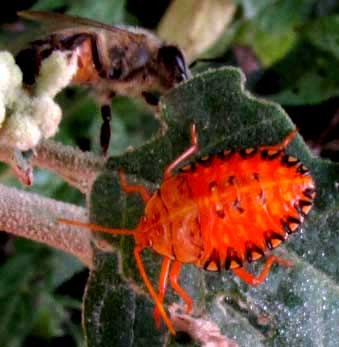Excerpts from Jim Conrad's
Naturalist Newsletter

from the January 31, 2016 Newsletter issued from Hacienda Chichen Resort beside Chichén Itzá Ruins; limestone bedrock; elevation ~39m (~128ft), N20.675°, W88.569°; central Yucatán state, MÉXICO
RED-BORDERED STINK BUG
On a chilly, dewy, overcast and somber morning, on a knee-high weed beside the road, a small patch of turquoise ornamented with orange-red caught my eye. Up close, it was bugs, shown above.
They're, "true bugs," of the "True Bug Order," the Hemiptera. The orange one at the left is a nymph, a wingless immature stage. A closer look at the nymph, with a honeybee below the nymph's leaf, similarly sheltering from the morning's chill and dew, appears below:

Soon after the pictures were sent to volunteer bug identifier Bea in Ontario she quickly shot back, "This was very easy to find, just googled "turquoise stink bug."
Our pretty discoveries are Red-bordered Stink Bugs, EDESSA RUFOMARGINATA, commonly distributed from Mexico south through Central America and South America to Argentina. Sometimes they're serious pests on crops, especially those in the Nightshade Family, the Solanaceae, including potato, tobacco and eggplant. Those in our picture are on a Nightshade Family member, a kind of nightshade itself, the genus Solanum. Because Red-bordered Stink Bugs are important to agriculture, there's plenty of information on the Internet about them.
For example, Daniel Silva and Paulo Oliveira in their 2010 online paper "Field Biology of Edessa rufomarginata (Hemiptera: Pentatomidae): Phenology, Behavior, and Patterns of Host Plant Use," in the journal Environmental Entomology, report that females generally lay 14 eggs in rows of seven each, with the mother not guarding them. The eggs hatch within seven to ten days. Nymphs cluster together until their third instar, when they scatter across the host plant. Our nymph is fairly large so it makes sense that it's alone, being in the scattered stage.
This is one of many "stink bugs" who defend themselves from attackers by secreting chemicals that stink and otherwise repel predators. When threatened they also vigorously shake their antennae, and if that doesn't help may hide among the leaves, or drop to the ground and hide in leaf litter, or simply fly away. Assassin bugs have been seen preying on both nymph and adult Red-bordered Stink Bugs. Certain ants gather nectar from droplets of "honeydew" the nymphs produce at their rear ends.